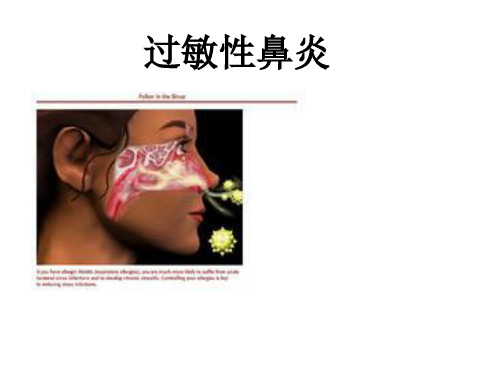《过敏性鼻炎》PPT课件
合集下载
过敏性鼻炎(新)PPT课件

下鼻甲成形术:减小下鼻甲体积,拓宽 鼻腔,解除鼻塞。对缓解鼻塞近期疗效 肯定,远期有待观察。
15
过敏性鼻炎的治疗(药物治疗)
➢糖皮质激素类药(内舒拿、辅舒良、雷诺考特 强的松片) ➢抗组胺药物(氯雷他定、枸地氯雷他定、左西替利嗪 爱赛平) ➢白三烯受体拮抗剂(顺尔宁) ➢肥大细胞稳定剂(色苷酸钠) ➢减充血剂(麻黄素,羟甲唑啉) ➢抗胆碱类药物(鼻用异丙托溴铵) ➢生理盐水或高渗盐水(2%~3%):用于鼻腔冲洗 ➢中药:部分中药对缓解鼻部症状有效,应根据辨证施治的原则选择药物
➢ 应采用标准化变应原疫苗,由具备资质的人 员进行操作。
18
免疫治疗
适应证: 临床诊断明确的AR患者即可采用变应原免
疫治疗,而不需要以药物治疗无效为前提 条件。
19
免疫治疗
国内目前免疫治疗的适应征主要为尘螨过 敏导致的中-重度持续性AR,合并其他变应 原数量少(1-2种),最好是单一尘螨过敏 的患者。
21
免疫治疗
禁忌证:
①伴有严重或未控制的哮喘及不可逆呼吸道阻塞疾病。 ②患者正在使用β受体阻断剂或血管紧张素转化酶阻滞剂 ③严重心血管疾病、免疫性疾病; ④严重心理障碍或患者无法理解治疗的风险和局限性 ⑤恶性肿瘤 ⑥妊娠期妇女。
22
外科治疗
外科治疗为AR的辅助治疗方法,临床 酌情使用。手术方式主要有2种类型;
平差距较大,可能导致AR患病状况出现较大 差异。 AR在我国大陆地区人口中患病率为4%-38%.
4
过敏性鼻炎的影响
生活质量 工作和学习效率 医疗费用 过敏性鼻炎患者有1/3合并哮喘,其余2/3无
哮喘的患者中又有2/3有支气管黏膜高反应性. 儿童哮喘患者93%有鼻炎,成人哮喘患者58%
15
过敏性鼻炎的治疗(药物治疗)
➢糖皮质激素类药(内舒拿、辅舒良、雷诺考特 强的松片) ➢抗组胺药物(氯雷他定、枸地氯雷他定、左西替利嗪 爱赛平) ➢白三烯受体拮抗剂(顺尔宁) ➢肥大细胞稳定剂(色苷酸钠) ➢减充血剂(麻黄素,羟甲唑啉) ➢抗胆碱类药物(鼻用异丙托溴铵) ➢生理盐水或高渗盐水(2%~3%):用于鼻腔冲洗 ➢中药:部分中药对缓解鼻部症状有效,应根据辨证施治的原则选择药物
➢ 应采用标准化变应原疫苗,由具备资质的人 员进行操作。
18
免疫治疗
适应证: 临床诊断明确的AR患者即可采用变应原免
疫治疗,而不需要以药物治疗无效为前提 条件。
19
免疫治疗
国内目前免疫治疗的适应征主要为尘螨过 敏导致的中-重度持续性AR,合并其他变应 原数量少(1-2种),最好是单一尘螨过敏 的患者。
21
免疫治疗
禁忌证:
①伴有严重或未控制的哮喘及不可逆呼吸道阻塞疾病。 ②患者正在使用β受体阻断剂或血管紧张素转化酶阻滞剂 ③严重心血管疾病、免疫性疾病; ④严重心理障碍或患者无法理解治疗的风险和局限性 ⑤恶性肿瘤 ⑥妊娠期妇女。
22
外科治疗
外科治疗为AR的辅助治疗方法,临床 酌情使用。手术方式主要有2种类型;
平差距较大,可能导致AR患病状况出现较大 差异。 AR在我国大陆地区人口中患病率为4%-38%.
4
过敏性鼻炎的影响
生活质量 工作和学习效率 医疗费用 过敏性鼻炎患者有1/3合并哮喘,其余2/3无
哮喘的患者中又有2/3有支气管黏膜高反应性. 儿童哮喘患者93%有鼻炎,成人哮喘患者58%
过敏性鼻炎PPT课件

临床辩证
●肺虚感寒证:常因感受风冷异气发病,恶风 寒,面白,气短,咳嗽,咯痰色白,苔薄白, 脉浮。
●脾气虚弱证:鼻痒而喷嚏连作,清涕量多, 四肢乏力,大便塘薄,鼻粘膜色淡红,舌淡, 苔白,脉细弱。
●肾阳亏虚证:鼻痒,鼻塞,喷嚏较多,遇风 冷 则易发作,畏寒肢冷,小便清长,大便澹 薄,鼻粘膜淡白,鼻甲水肿,舌淡,苔白,脉 沉细。
●鼻塞:常随体位变动而改变,如左侧卧则左 鼻塞而右鼻通,右侧卧则右鼻堵而左鼻通。鼻 塞是鼻炎的特征性表现,可见小儿不断用手指 或手掌擦鼻前部,该动作称“变态反应性仪容 ”。
临床表现
眼睛发红发痒及流泪
耳闷 眼眶下黑眼圈
其它 表现 症状
经口呼 嗅觉下降或者消失
头昏,头痛
表皮破裂
儿童可揉鼻子出现过敏性敬礼症
循经远端取穴。足三里穴又为补益要穴,用该穴可以“培土生金”,补益脾肺之气,以达益气固表、 扶正祛邪之功。根据实验研究表明足三里穴无论是对细胞免疫还是体液免疫都有很好的调节作用。
上星:属督脉的穴位,可通利鼻窍。督脉为阳脉之海,督脉统一身的阳气,且循行过鼻,因此选取
针刺上星有助于升提人体之阳气,利于鼻腔以抵御外邪的侵袭,同时此穴能温通经脉,疏风解表。
鼻黏膜慢性 炎症
鼻黏膜高反 应
病因病机
●中医
1.卫气虚弱,外邪侵袭
鼻与肺卫的关系最为密切,肺气虚弱,风寒袭肺,上犯于鼻,是本 病发病的重要病因。《素问.五脏别论》:“心肺有病而鼻为之不利也.” 肺主宣发,如肺气虚弱,风寒之邪侵袭,内犯于肺,上侵于鼻,津液不 得输布,流溢为涕,而至鼻鼽。
2.肺失温煦,寒湿内犯
中医外治法
《扁鹊心法》云:“人于无病时,常灸关元、气海、命门、 中 脘 ,虽未得长生,亦可保百余年寿矣。”灸法通过温热作 用刺激身体的穴位或特定部位,以补充身体正气,以祛除外 邪,治疗由风寒、湿浊等内蕴所致的过敏性鼻炎。
小儿过敏性鼻炎的预防PPT课件

小儿过敏性鼻炎的预防
演讲人:
目录
1. 什么是小儿过敏性鼻炎? 2. 为什么要预防小儿过敏性鼻炎? 3. 何时进行预防? 4. 如何进行预防? 5. 总结与建议
什么是小儿过敏性鼻炎?
什么是小儿过敏性鼻炎? 定义
小儿过敏性鼻炎是一种由过敏原引起的鼻腔炎症 ,常见于儿童。
常见症状包括打喷嚏、流鼻涕、鼻塞和瘙痒。
过敏性鼻炎可能影响儿童的学习和生活。
为预防能减少哮喘及其他呼吸系统疾病的 发生。
过敏性鼻炎与哮喘有密切关系,需引起重视 。
为什么要预防小儿过敏性鼻炎? 降低医疗费用
预防措施可以降低因疾病产生的医疗支出。
长期的过敏性鼻炎治疗费用较高。
何时进行预防?
何时进行预防?
日常生活中
应在季节变化时提前采取预防措施。
尤其在花粉季节,注意减少户外活动。
何时进行预防?
家中环境
保持家中环境清洁、无尘,定期清洗床上用品。
使用防尘螨的床垫和枕头套。
何时进行预防?
定期检查
定期带孩子就医,进行过敏原检测。
及时了解孩子的过敏情况,制定个性化预防方案 。
如何进行预防?
如何进行预防? 避免过敏原
培养孩子良好的生活习惯,增强自我保护意识。
如勤洗手、保持环境卫生等。
总结与建议
家长的角色
家长需关注孩子的健康变化,及时就医。
共同营造一个健康的生活环境是关键。
总结与建议
持续关注
关注最新的过敏性鼻炎研究与预防知识。
与医生保持沟通,及时获取专业建议。
谢谢观看
什么是小儿过敏性鼻炎? 发病原因
主要由花粉、尘螨、动物皮屑等过敏原引发。
环境因素、遗传因素也会影响发病率。
演讲人:
目录
1. 什么是小儿过敏性鼻炎? 2. 为什么要预防小儿过敏性鼻炎? 3. 何时进行预防? 4. 如何进行预防? 5. 总结与建议
什么是小儿过敏性鼻炎?
什么是小儿过敏性鼻炎? 定义
小儿过敏性鼻炎是一种由过敏原引起的鼻腔炎症 ,常见于儿童。
常见症状包括打喷嚏、流鼻涕、鼻塞和瘙痒。
过敏性鼻炎可能影响儿童的学习和生活。
为预防能减少哮喘及其他呼吸系统疾病的 发生。
过敏性鼻炎与哮喘有密切关系,需引起重视 。
为什么要预防小儿过敏性鼻炎? 降低医疗费用
预防措施可以降低因疾病产生的医疗支出。
长期的过敏性鼻炎治疗费用较高。
何时进行预防?
何时进行预防?
日常生活中
应在季节变化时提前采取预防措施。
尤其在花粉季节,注意减少户外活动。
何时进行预防?
家中环境
保持家中环境清洁、无尘,定期清洗床上用品。
使用防尘螨的床垫和枕头套。
何时进行预防?
定期检查
定期带孩子就医,进行过敏原检测。
及时了解孩子的过敏情况,制定个性化预防方案 。
如何进行预防?
如何进行预防? 避免过敏原
培养孩子良好的生活习惯,增强自我保护意识。
如勤洗手、保持环境卫生等。
总结与建议
家长的角色
家长需关注孩子的健康变化,及时就医。
共同营造一个健康的生活环境是关键。
总结与建议
持续关注
关注最新的过敏性鼻炎研究与预防知识。
与医生保持沟通,及时获取专业建议。
谢谢观看
什么是小儿过敏性鼻炎? 发病原因
主要由花粉、尘螨、动物皮屑等过敏原引发。
环境因素、遗传因素也会影响发病率。
过敏性鼻炎简介 ppt课件

ppt课件 20
抗组胺药物
优点: 快速缓解症状:1小时内1 口服(全身应用)可同时改善伴随的眼部 症状1以及下呼吸道症状2 缺点或副作用3: 非抗炎性抗组胺药对鼻堵效果差 第一代抗组胺药有明显嗜睡作用 特非那定,阿司咪唑明确有心脏毒性
ppt课件 21
抗组胺药物是变应性鼻炎治疗的首选 用药,适于各种类型变应性鼻炎
ppt课件
11
过敏性鼻炎危害
基本病理变化为毛细血管扩张、通透性 增加和腺体分泌增加以及嗜酸粒细胞浸 润等。 上述病理改变缓解期可恢复正常,反复 发作,可引起黏膜上皮层增殖性改变, 导致黏膜肥厚及息肉样变。如合并感染, 可表现为黏脓涕或脓涕。
ppt课件 12
过敏性鼻炎诱发多种疾病
过敏性眼结膜炎
过敏性鼻炎简介
ppt课件
1
目录什么是过敏Fra bibliotek过敏性鼻炎的症状
形成原因 如何预防
治疗方法
ppt课件 2
什么是过敏
当人体被抗原物质(过敏原)致敏后,再 次受到同一抗原物质刺激时所产生的一种 异常的或者病理性的免疫反应称为过敏
ppt课件
3
初次 过敏原 机体
产生
IgE
IgE与肥大细胞、嗜碱性粒细胞Fc受体结合 再次
8
过敏性鼻炎成因
其成因是具有过敏性体质的人,在接触 过敏原之后,因过敏源与体内抗原结合, 经过一些列的免疫反应,造成肥大细胞 破裂。破裂的肥大细胞释放出组织胺及 一些化学物质,这些组织胺及一些化学 物质会使得鼻腔粘膜产生发炎反应,继 而出现流鼻水、打喷嚏等症状。
ppt课件
9
组织胺
Vessel
抗组胺药物
优点: 快速缓解症状:1小时内1 口服(全身应用)可同时改善伴随的眼部 症状1以及下呼吸道症状2 缺点或副作用3: 非抗炎性抗组胺药对鼻堵效果差 第一代抗组胺药有明显嗜睡作用 特非那定,阿司咪唑明确有心脏毒性
ppt课件 21
抗组胺药物是变应性鼻炎治疗的首选 用药,适于各种类型变应性鼻炎
ppt课件
11
过敏性鼻炎危害
基本病理变化为毛细血管扩张、通透性 增加和腺体分泌增加以及嗜酸粒细胞浸 润等。 上述病理改变缓解期可恢复正常,反复 发作,可引起黏膜上皮层增殖性改变, 导致黏膜肥厚及息肉样变。如合并感染, 可表现为黏脓涕或脓涕。
ppt课件 12
过敏性鼻炎诱发多种疾病
过敏性眼结膜炎
过敏性鼻炎简介
ppt课件
1
目录什么是过敏Fra bibliotek过敏性鼻炎的症状
形成原因 如何预防
治疗方法
ppt课件 2
什么是过敏
当人体被抗原物质(过敏原)致敏后,再 次受到同一抗原物质刺激时所产生的一种 异常的或者病理性的免疫反应称为过敏
ppt课件
3
初次 过敏原 机体
产生
IgE
IgE与肥大细胞、嗜碱性粒细胞Fc受体结合 再次
8
过敏性鼻炎成因
其成因是具有过敏性体质的人,在接触 过敏原之后,因过敏源与体内抗原结合, 经过一些列的免疫反应,造成肥大细胞 破裂。破裂的肥大细胞释放出组织胺及 一些化学物质,这些组织胺及一些化学 物质会使得鼻腔粘膜产生发炎反应,继 而出现流鼻水、打喷嚏等症状。
ppt课件
9
组织胺
Vessel
过敏性鼻炎ppt

-
过敏性鼻炎
4、降低神经兴奋性:
电烧、冷冻、双极电凝、 微波、等离子等
5、腔镜下微创手术疗法:
纠正结构异常, 如鼻中膈弯曲、
鼻甲肥厚、鼻窦炎、鼻息肉
-
过敏性鼻炎
治疗 6、中医中药 7、其他
冲洗 生理盐水 理疗 红光照射 生活调理
-
过敏性鼻炎
盐水洗鼻
借用专用工具 使用生理盐水或者自己配置的无碘盐 冲洗鼻腔 以期冲掉鼻腔内致炎因子或赃物 治疗和预防过敏性鼻炎、鼻窦炎
过敏性鼻炎 (allergic rhinitis)
新乡市第一人民医院耳鼻喉科 新乡市耳鼻咽喉-头颈外科学诊治中心
新乡市耳鼻喉科腔镜中心 孙志强
-
过敏性鼻炎
• 定义 • 是如何引起的? • 与感冒如何鉴别? • 引起哮喘? • 都有哪些治疗措施,能根治吗? • 抗组胺药? • 激素可以用吗? • 手术 适应症
-
过敏性鼻炎
特殊病人的治疗 • 孕妇 • 小儿 • 注意是否合并有
打鼾 扁桃体炎 同时治疗鼻窦炎
-
过敏性鼻炎
• 治疗过敏性性鼻炎的误区:
一、仅药物内服:
ቤተ መጻሕፍቲ ባይዱ
药效分散,见效慢,花费大,影响肝、肾等脏器功能
二、滥用减充血剂滴鼻
时间稍长,易导致药物性鼻炎
三、寻求根治办法,激光、高频——减敏
手术
—— 纠正解剖异常
-
-
过敏性鼻炎
机理
抗原物质
20 年代低于1%,50年代至80年代逐渐上升,80年代以后戏剧性上升。 瑞士 1926年0.82%
1958年4.8% 1985年9.6% 1995年14.2% 东西德统一之前,西德明显高于东德, 但在统一多年后的今天,过敏性疾病的发病情况已没有区别
《过敏性鼻炎》课件

抗白三烯药物:如孟鲁司特、扎鲁司特等, 用于减轻鼻黏膜炎症反应和哮喘症状
鼻用激素:如氟替卡松、莫米松等,用于 减轻鼻黏膜炎症反应
免疫疗法:如脱敏治疗,用于减轻过敏症 状,但需要长期治疗
减充血剂:如麻黄碱、去氧肾上腺素等, 用于缓解鼻塞症状
中成药:如鼻炎片、鼻炎康等,用于缓解 鼻塞、流涕等症状
免疫疗法
饮食调理:多吃 富含维生素C和 维生素E的食物, 如新鲜蔬菜、水 果等,增强免疫 力
适当运动:适当 进行户外运动, 增强体质,提高 免疫力
过敏性鼻炎的并 发症和注意事项
并发症的预防和处理
避免接触过敏原:避免接触花粉、尘螨、宠物皮屑等过敏原 保持室内空气流通:保持室内空气流通,减少过敏原的聚集 定期清洗鼻腔:定期清洗鼻腔,减少过敏原的积累 及时就医:出现并发症时,应及时就医,接受专业治疗
保持室内湿度适中,避免 过于干燥或潮湿
避免食用容易引起过敏的 食物,如海鲜、牛奶、鸡 蛋等
定期进行身体检查,及时 发现并治疗过敏性疾病
增强免疫力
均衡饮食:摄入 足够的蛋白质、 维生素和矿物质, 保持营养均衡
适量运动:每周 至少进行150分 钟的有氧运动, 如跑步、游泳、 骑自行车等
充足睡眠:保证 每晚7-8小时的 高质量睡眠,有 助于提高免疫力
免疫疗法的注意事项:需要在医生指导下进行,并定期复 查
手术治疗
手术目的:减轻症 状,改善生活质量
手术方式:鼻内镜 手术、鼻窦手术等
手术风险:术后感 染、出血、神经损 伤等
术后护理:保持鼻 腔清洁,避免刺激 性气味,定期复查
免疫疗法:通过注射或口服药物, 提高身体对过敏原的耐受性
其他疗法
针灸疗法:通过刺激特定穴位,减 轻鼻塞、流涕等症状
过敏性鼻炎护理及预防ppt课件

ad是痴呆最常见的原因之一病史详细询问病史分析症状发作时间和诱发因素有无哮喘评估症状严重程度具有鼻痒喷嚏鼻分泌物和鼻塞4大症状中至少3项症状持续051h以上每年发病季节基本一致且与致敏花粉传粉期相符合至少2年在同一季节发病是季节性鼻炎seasonalrhinitis或花粉症pollinosis的特点常年性鼻炎在一年中发病时间累计超过8个月阿尔茨海默病是老年性痴呆中的一种类型属于皮质变性痴呆起病浅隐缓慢渐进加重是一种不可逆性痴呆
远离得意的宠物 选择无皮毛的小动物,如海龟、金鱼等; 有毛发的小动物要养在室外 与宠物接触后,要清理身上接触过的地方,包括衣物
过敏性鼻炎的药物治疗
近年来高效、长效、平安的药物不断问世 药物治疗在过敏性鼻炎治疗中占有重要位置。主要有 抗组胺药物 糖皮质激素类药 减充血剂 白三烯受体拮抗剂 肥大细胞稳定剂
2
年年性鼻炎(perennial rhinitis)
后者可有季节性加重
过敏性鼻炎的临床分类
• 季节性鼻炎(seasonal rhinitis) • 变应原主要为室外以风作为传播方式的植物花粉,
发病时间与花粉播散季节一致,因此又称花粉症 (pollinosis〕
过敏性鼻炎的临床分类
• 年年性鼻炎(perennial rhinitis) • 变应原主要在室内,与患者长期接触 • 室内变应原种类繁多,包括 • 尘螨 • 宠物皮屑 • 羽毛 • 真菌等 • 近年家居装修呵斥的室内挥发性
过敏性鼻炎的发病机理
• IgE介导机制
• 这是过敏性鼻炎发病的主要机 制。
• 过敏性鼻炎发病有两个阶段
致敏
激发
•
过敏性鼻炎的临床特征
• 频繁发作的喷嚏 • 阵发性 • 每日数次至十数
次〔晨起多发〕 • 过量的鼻分泌物 • • 显著鼻塞
远离得意的宠物 选择无皮毛的小动物,如海龟、金鱼等; 有毛发的小动物要养在室外 与宠物接触后,要清理身上接触过的地方,包括衣物
过敏性鼻炎的药物治疗
近年来高效、长效、平安的药物不断问世 药物治疗在过敏性鼻炎治疗中占有重要位置。主要有 抗组胺药物 糖皮质激素类药 减充血剂 白三烯受体拮抗剂 肥大细胞稳定剂
2
年年性鼻炎(perennial rhinitis)
后者可有季节性加重
过敏性鼻炎的临床分类
• 季节性鼻炎(seasonal rhinitis) • 变应原主要为室外以风作为传播方式的植物花粉,
发病时间与花粉播散季节一致,因此又称花粉症 (pollinosis〕
过敏性鼻炎的临床分类
• 年年性鼻炎(perennial rhinitis) • 变应原主要在室内,与患者长期接触 • 室内变应原种类繁多,包括 • 尘螨 • 宠物皮屑 • 羽毛 • 真菌等 • 近年家居装修呵斥的室内挥发性
过敏性鼻炎的发病机理
• IgE介导机制
• 这是过敏性鼻炎发病的主要机 制。
• 过敏性鼻炎发病有两个阶段
致敏
激发
•
过敏性鼻炎的临床特征
• 频繁发作的喷嚏 • 阵发性 • 每日数次至十数
次〔晨起多发〕 • 过量的鼻分泌物 • • 显著鼻塞
过敏性鼻炎.ppt

过敏性鼻炎 (Allergic Rhinitis)
1 视频案例分析 2 过敏性鼻炎的发生机制 3 过敏性鼻炎的防治原则 4 小结和思考题
一、临床案例分析
1、过敏性鼻炎由哪些过敏原引起的呢? 2、过敏性鼻炎的症状是什么? 3、我们该如何防治呢?
超敏反应(Hypersensitivity) 指机体受到某些抗原刺激时,出现生理功能紊乱或
改善效 应器官 的药物
生物活 性介质 拮抗药
血管扩 张水肿
肾上 腺素
扑尔敏 葡萄糖
IgG
酸钙
三、 防治原则
1、查明变应原,避免接触
2、脱敏治疗
小剂量—间隔时间长—反复多次皮下注射
3、药物防治:
➢ 抑制生物活性介质释放的药物: (1)色苷酸二钠 (2)肾上腺素、异丙肾上腺素、儿茶酚胺类
➢ 生物活性介质拮抗剂: (1)组胺拮抗剂 --- 苯海拉明、扑尔敏、异丙嗪等; (2)缓激肽拮抗剂 --- 水杨酸;
组织细胞损伤等异常的适应性免疫应答。
超敏反应(Hypersensitivity) Ⅰ 型超敏反应 Ⅱ 型超敏反应 Ⅲ 型超敏反应 Ⅳ 型超敏反应
一、临床案例分析
宠物变应原:动物毛发
室内变应原:尘螨、真菌孢子
室外变应原:树木花粉
二、过敏性鼻炎的发生机制
(1)变应原 (2)IgE及其受体FcεRⅠ (3)肥大细胞和嗜碱性粒细胞
➢ 改善效应器官反应:肾上腺素
4、免疫生物疗法
三、 防治原则
鼻腔冲洗
鼻腔防护
小结
1、掌握超敏反应的概念、类型; 2、掌握过敏性鼻炎的发生机制; 3、过敏性鼻炎的防治。
习题
1、Ⅰ型超敏反应中重要的效应细胞是() A.中性粒细胞 B.肥大细胞 C.树突状细胞 D.巨噬细胞 E.NK细胞
1 视频案例分析 2 过敏性鼻炎的发生机制 3 过敏性鼻炎的防治原则 4 小结和思考题
一、临床案例分析
1、过敏性鼻炎由哪些过敏原引起的呢? 2、过敏性鼻炎的症状是什么? 3、我们该如何防治呢?
超敏反应(Hypersensitivity) 指机体受到某些抗原刺激时,出现生理功能紊乱或
改善效 应器官 的药物
生物活 性介质 拮抗药
血管扩 张水肿
肾上 腺素
扑尔敏 葡萄糖
IgG
酸钙
三、 防治原则
1、查明变应原,避免接触
2、脱敏治疗
小剂量—间隔时间长—反复多次皮下注射
3、药物防治:
➢ 抑制生物活性介质释放的药物: (1)色苷酸二钠 (2)肾上腺素、异丙肾上腺素、儿茶酚胺类
➢ 生物活性介质拮抗剂: (1)组胺拮抗剂 --- 苯海拉明、扑尔敏、异丙嗪等; (2)缓激肽拮抗剂 --- 水杨酸;
组织细胞损伤等异常的适应性免疫应答。
超敏反应(Hypersensitivity) Ⅰ 型超敏反应 Ⅱ 型超敏反应 Ⅲ 型超敏反应 Ⅳ 型超敏反应
一、临床案例分析
宠物变应原:动物毛发
室内变应原:尘螨、真菌孢子
室外变应原:树木花粉
二、过敏性鼻炎的发生机制
(1)变应原 (2)IgE及其受体FcεRⅠ (3)肥大细胞和嗜碱性粒细胞
➢ 改善效应器官反应:肾上腺素
4、免疫生物疗法
三、 防治原则
鼻腔冲洗
鼻腔防护
小结
1、掌握超敏反应的概念、类型; 2、掌握过敏性鼻炎的发生机制; 3、过敏性鼻炎的防治。
习题
1、Ⅰ型超敏反应中重要的效应细胞是() A.中性粒细胞 B.肥大细胞 C.树突状细胞 D.巨噬细胞 E.NK细胞
过敏性鼻炎ppt课件

鼻腔解剖、病理结构
1
鼻腔外侧壁(右)
2
3
4
过敏性鼻炎的诊治
5
概述
过敏性鼻炎是指鼻腔粘膜的变异性疾病,是由 IgE介导的1型变态反应,故又称变应性鼻炎, 是多种免疫细胞和细胞因子等参与的鼻粘膜非 感染性疾病,可引起多种并发症。主要临床表 现为患者常有阵发性喷嚏、清水样鼻涕,伴有 不同程度的鼻塞和鼻痒。由于过敏性鼻炎具有 多种免疫细胞的参与,患者常伴有不同程度的 免疫力低下。目前治疗的药物较多,但根治率 不高,大部分药物都是改善患者的症状,这也 是目前基础和临床研究的热点。
6
病因
1、吸入性过敏原:如室内外尘埃、 尘螨、真菌、动物皮毛、羽毛、棉
絮等多引起常年性发作,花粉常引 起季节性发作;
2、食物性过敏原:如鱼、虾、蛋、 奶、面粉、花生、大豆等;
3、药物性过敏原:如磺胺类药物、 奎宁、抗生素等;
4、接触物:如化妆品、油漆、酒精 等;
5、其他:某些细菌、病毒或毒素,
物理因素如冷热变化等。
7
流行病学
lAR是全球性健康问题. l是各种过敏性疾病中,发病率最高. l国外报道10-20% ,部分发到国家甚至高达30%. l我国地域辽阔,不同地区环境、气候、经济水
平差距较大,可能导致AR患病状况出现较大 差异。 lAR在我国大陆地区人口中患病率为4%-38%.
8
影响
生活质量 工作和学习效率 医疗费用 过敏性鼻炎患者有1/3合并哮喘,其余2/3无哮喘的患
10
发病机制
激发过程包括速发相和迟发相。 速发相出现在激发后30分钟内,主要由肥大
细胞及嗜碱性粒细胞释放组胺介导,导致毛 细血管扩张、通透性增加、腺体分泌增多, 从而引起临床症状包括鼻痒、喷嚏、流涕、 鼻塞。 迟发相出现在变应原激发后6-12h,主要由嗜酸 性粒细胞释放炎性介质介导,引起临床症状 包括鼻塞、鼻痒、喷嚏、流涕。
1
鼻腔外侧壁(右)
2
3
4
过敏性鼻炎的诊治
5
概述
过敏性鼻炎是指鼻腔粘膜的变异性疾病,是由 IgE介导的1型变态反应,故又称变应性鼻炎, 是多种免疫细胞和细胞因子等参与的鼻粘膜非 感染性疾病,可引起多种并发症。主要临床表 现为患者常有阵发性喷嚏、清水样鼻涕,伴有 不同程度的鼻塞和鼻痒。由于过敏性鼻炎具有 多种免疫细胞的参与,患者常伴有不同程度的 免疫力低下。目前治疗的药物较多,但根治率 不高,大部分药物都是改善患者的症状,这也 是目前基础和临床研究的热点。
6
病因
1、吸入性过敏原:如室内外尘埃、 尘螨、真菌、动物皮毛、羽毛、棉
絮等多引起常年性发作,花粉常引 起季节性发作;
2、食物性过敏原:如鱼、虾、蛋、 奶、面粉、花生、大豆等;
3、药物性过敏原:如磺胺类药物、 奎宁、抗生素等;
4、接触物:如化妆品、油漆、酒精 等;
5、其他:某些细菌、病毒或毒素,
物理因素如冷热变化等。
7
流行病学
lAR是全球性健康问题. l是各种过敏性疾病中,发病率最高. l国外报道10-20% ,部分发到国家甚至高达30%. l我国地域辽阔,不同地区环境、气候、经济水
平差距较大,可能导致AR患病状况出现较大 差异。 lAR在我国大陆地区人口中患病率为4%-38%.
8
影响
生活质量 工作和学习效率 医疗费用 过敏性鼻炎患者有1/3合并哮喘,其余2/3无哮喘的患
10
发病机制
激发过程包括速发相和迟发相。 速发相出现在激发后30分钟内,主要由肥大
细胞及嗜碱性粒细胞释放组胺介导,导致毛 细血管扩张、通透性增加、腺体分泌增多, 从而引起临床症状包括鼻痒、喷嚏、流涕、 鼻塞。 迟发相出现在变应原激发后6-12h,主要由嗜酸 性粒细胞释放炎性介质介导,引起临床症状 包括鼻塞、鼻痒、喷嚏、流涕。
小儿过敏性鼻炎科普讲座PPT课件

1. 什么是过敏性鼻炎
影响:会影响儿童的生活质量和学习表 现。
2. 过敏性鼻 炎的原因
2. 过敏性鼻炎的原因
过敏源:花粉、尘螨、宠物毛 发等常见过敏原。 过敏反应:免疫系统对过敏源 产生超敏反应,导致鼻部炎症 和症状。
3. 如何预防 过敏性鼻炎
3. 如何预防过敏性鼻炎
避免接触过敏原:保持室内清洁,定期 清洗床上用品。 注意饮食:合理搭配饮食,增强免疫力 。
3. 如何预防过敏性鼻炎
增强体质:适度进行体育锻炼,增 强身体抵抗力。
4. 过敏性鼻 炎的治疗方法
4. 过敏性鼻炎的治疗方法
药物治疗:口服抗过敏药物、使用鼻喷 剂等。 免疫疗法:采用免疫调节治疗,减少过 敏反应。
4. 过敏性鼻炎的治疗方法
鼻部手术:对于严重鼻塞无效 的患者,可以考虑手术治疗。
小儿过敏性鼻炎科普讲座PPT 课件
பைடு நூலகம்
目录 1. 什么是过敏性鼻炎 2. 过敏性鼻炎的原因 3. 如何预防过敏性鼻炎 4. 过敏性鼻炎的治疗方法 5. 小儿过敏性鼻炎的并发症 6. 小儿过敏性鼻炎的护理建议
1. 什么是过 敏性鼻炎
1. 什么是过敏性鼻炎
定义:过敏性鼻炎是一种常见的鼻 部疾病,多数发生在儿童身上。 症状:打喷嚏、流鼻涕、鼻塞、瘙 痒等。
6. 小儿过敏性鼻炎的护理建议
定期复诊:定期就诊跟踪治疗 效果,预防病情复发。
谢谢您的观赏聆听
5. 小儿过敏 性鼻炎的并发
症
5. 小儿过敏性鼻炎的并发症
鼻窦炎:鼻部炎症扩散至鼻窦,引起鼻 头疼痛。 中耳炎:鼻部炎症导致儿童中耳感染。
5. 小儿过敏性鼻炎的并发症
哮喘发作:鼻炎引起的炎症反应可 能引发哮喘症状。
防止过敏性鼻炎的健康教育PPT

生活中的注意事项
注意饮食健康 积极管理压力
总结
总结
防止过敏性鼻炎的重要性再强调 重要的预防和管理方法再次提及
总结
鼓励患者寻求医生的帮助和专 业咨询
谢谢您的 观赏聆听
过敏原的种类和常见来源
预防过过敏原接触 - 定期清洁家居环境 - 避免宠物接触 - 注意花粉季节的防护
预防过敏性鼻炎的方法
保持良好的室内空气质量 - 室内通风 - 使用空气净化器
预防过敏性鼻炎的方法
增强免疫力 - 健康饮食 - 适度锻炼 - 充足睡眠
过敏性鼻炎的 治疗与管理
过敏性鼻炎的治疗与管理
药物治疗 - 去除过敏原的药物 - 缓解症状的药物
过敏性鼻炎的治疗与管理
居家护理 - 温水漱口 - 鼻腔清洗
过敏性鼻炎的治疗与管理
就医和专业咨询的重要性 - 寻求医生的帮助 - 接受过敏原检测 - 合理使用药物
生活中的注意 事项
生活中的注意事项
避免吸烟和二手烟 避免接触化学刺激物
防止过敏性鼻 炎的健康教育
PPT
目录 简介 认识过敏性鼻炎 预防过敏性鼻炎的方法 过敏性鼻炎的治疗与管理 生活中的注意事项 总结
简介
简介
防止过敏性鼻炎的重要性 过敏性鼻炎的定义和症状
简介
过敏性鼻炎对生活质量的影响
认识过敏性鼻 炎
认识过敏性鼻炎
什么是过敏性鼻炎 过敏性鼻炎的常见症状
认识过敏性鼻炎
- 1、下载文档前请自行甄别文档内容的完整性,平台不提供额外的编辑、内容补充、找答案等附加服务。
- 2、"仅部分预览"的文档,不可在线预览部分如存在完整性等问题,可反馈申请退款(可完整预览的文档不适用该条件!)。
- 3、如文档侵犯您的权益,请联系客服反馈,我们会尽快为您处理(人工客服工作时间:9:00-18:30)。
.
10
•decongestants Decongestants help by making the blood vessels in the nose smaller, thus, decreasing congestion.
If patient do not respond to avoidance or
to five year course of repeated injections
of specific allergens to decrease the
reaction to these allergens when you
•steroid nasal sprays Steroid nasal sprays also help to decrease the swelling in the nose. Steroid nasal sprays work best when used before the symptoms start, but can also be used during a flare-up.
• sneezing
• congestion
• runny nose
• itchy nose, throat, eyes, and ears
• nosebleeds
• clear drainage from the nose
• loss of smell
.
5
Children with perennial allergic rhinitis may also have the following:
.
4
What are the symptoms of allergic rhinitis?
The following are the most common symptoms of allergic rhinitis. However, each person may experience symptoms differently. Symptoms may include:
the year
.
3
What are the causes of allergic rhinitis?
The most common causes of allergic rhinitis include the following:
• pollen • dust mites • mold • animal dander
.
8
Treatment for allergic rhinitis:
Treatment options may include: •avoidance of the allergens Avoidance of the allergens that are causing the problem is the best treatment.
• antihistamines Antihistamines help to decrease the release of histamine, possibly decreasing the symptoms of itching, sneezing, or runny nose.
.
9
•anti-inflammatory nasal sprays Anti-inflammatory nasal sprays help to decrease the swelling in the nose.
• The turbinates appear swollen. • If there is an associated infection, the
secretions range from thin and mucoid to thick and purulent. • Polyps.
.
7
Nasal examination
to the above medications, we may refer
you to an allergist for testing. The
allergist then may recommend
immunotherapy based on the findings.
Immunotherapy usually involves a three
.
2
What are the types of allergic rhinitis?
The two categories of allergic rhinitis include: • seasonal - occurs particularly
during pollen seasons. • perennial - occurs throughout
Allergic Rhinitis
.
1
What is allergic rhinitis?
• Rhinitis is a reaction that occurs in the nose when airborne irritants (allergens) trigger the release of histamine. Histamine causes inflammation and fluid production in the fragile linings of nasal passages, sinuses, and eyelids. • There is usually a family history of allergic rhinitis.
• recurrent ear infections • snoring • mouth breathing • fatigue • poor performance in sche nasal examination of allergic rhinitis?
• The nasal mucosa is moist and pale, grayish pink in color.
